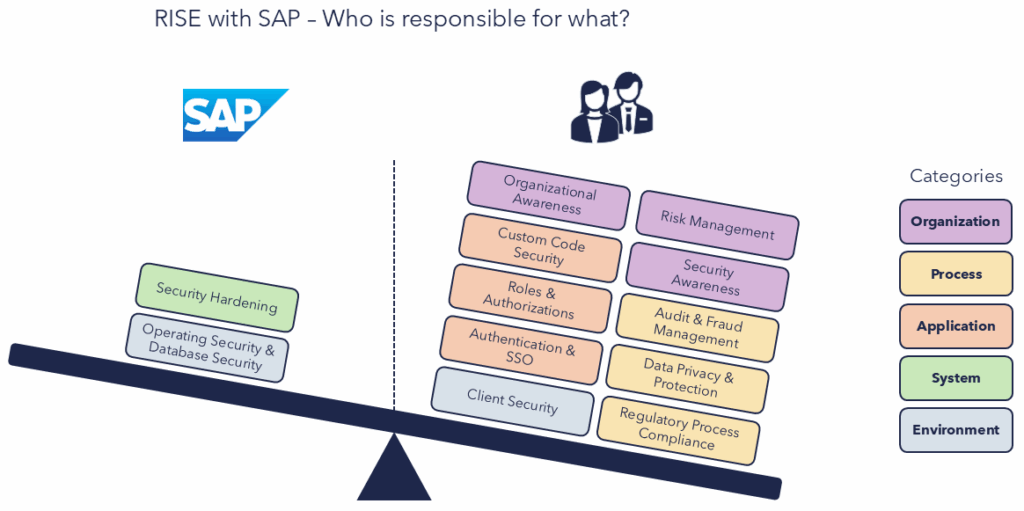
In the context of today’s rapidly evolving digital environment, businesses find themselves under considerable pressure to enhance their agility, data-driven decision-making capabilities, and customer service levels. The transition to cloud-based business models is no longer seen as a choice, but as a strategic requirement. To address this challenge, SAP has introduced RISE with SAP, a comprehensive solution designed to modernize legacy ERP systems and transition businesses to a cloud-centric, modular business architecture.
Despite its promise of simplification, RISE leaves much of the heavy lifting – strategy, data migration, custom code security, system configuration and change management – to the customer. So the question remains: how are the responsibilities distributed between SAP and its customer, and is the balance sufficient to ensure a successful transformation?
- What is RISE with SAP?
- The Shared Responsibility Reality in RISE
- Secure and Compliant RISE Transformation with smarterSec
- Conclusion
What is RISE with SAP?
RISE with SAP is SAP’s bundled offering designed to assist existing on-premises ERP customers in their transition to SAP Business Suite. Rather than offering a single product, it provides a package that includes cloud infrastructure, business process redesign tools, technical migration support, and access to SAP S/4HANA Cloud (Private Edition). It is intended to reduce complexity, increase the business resilience and accelerate digital transformation.
Why does RISE matter for my business transformation?
Business transformations are rarely straightforward. For many companies, the gap between strategic ambition and execution is widened by outdated systems, fragmented data landscapes, and years of costly customizations. These legacy challenges often make modernization efforts slow, complex, and risky.
While RISE offers a structured path to cloud adoption, the real-world execution still requires significant planning, customization, and internal change management on the customer’s side. Let’s take a closer look at what RISE covers and what remains the customer’s responsibility.
The Shared Responsibility Reality in RISE
SAP’s marketing material creates the impression that RISE covers a significant part of the transformation project and takes on a substantial amount of responsibility for the customer. However, a closer look reveals that RISE only takes on a small part of the transformation process, with the customer still having to carry out the majority of it themselves:

Responsibilities that are shared by SAP and the customer are:
- Network Security (Environment)
- Secure SAP Code (System)
- Security Monitoring & Forensics (System)
- User & Identity Management (Application)
To fill these gaps, left by SAP, and mitigate potential risks during the transformation of your landscape, smarterSec provides comprehensive security solutions. These solutions ensure a seamless and error-free migration, relieving customers of additional responsibilities.
Secure and Compliant RISE Transformation with smarterSec
Our support for RISE is structured across three key phases: before, during and after your migration. Here’s how we can help your business to achieve its full potential in a secure and confident manner by taking on further responsibilities within the transformation project.
Before Migration: Prepare for a Secure and Compliant Start
The objective of this phase is to assess the current state of the system landscape and identify any potential risks, with the goal of ensuring a seamless transition.
During Migration: Build Security into the Process
The objective of this phase is to implement security controls and compliance measures throughout the migration activities. This will ensure that data, configurations, and access rights are protected as systems and processes are being transformed.
After Migration: Maintain a Secure and Compliant SAP Landscape
Security is not a one-time effort: threats, configurations, and compliance requirements are in constant change. Without ongoing visibility, even well-secured systems will become vulnerable over time.
Conclusion
RISE with SAP assists businesses in their transformation journey by reducing complexity, increasing resilience, and accelerating digital transformation. However, the primary responsibilities fall on the customers’ shoulders, with SAP’s role being limited to a small portion of the overall scope. This is where smarterSec provides a valuable asset.
By combining deep SAP expertise with comprehensive and target-oriented security tools, we help you balance the responsibilities of your RISE project. From data minimization before the migration to an ongoing security monitoring with our smarterSec Security Platform (SSP) after the migration – we ensure your journey is not only smooth, but secure and future proof.
Further blogs and videos you might be interested in: